Advanced wellbore placement techniques may provide long-term benefits in East Africa
 Although Africa takes up approximately a fifth of the Earth’s landmass and contains approximately 10% of the world’s proved oil reserves – almost double that of North America’s – there are far fewer publications that specifically deal with E&P challenges in Africa than for other regions. Presenting his paper, “Wellbore Positioning Practices and Challenges in Africa,” this week at the 2011 SPE/IADC Drilling Conference in Amsterdam, Baker Hughes’ Gary Skinner noted the lack of advanced while-drilling wellbore surveying techniques and collision management in East Africa.
Although Africa takes up approximately a fifth of the Earth’s landmass and contains approximately 10% of the world’s proved oil reserves – almost double that of North America’s – there are far fewer publications that specifically deal with E&P challenges in Africa than for other regions. Presenting his paper, “Wellbore Positioning Practices and Challenges in Africa,” this week at the 2011 SPE/IADC Drilling Conference in Amsterdam, Baker Hughes’ Gary Skinner noted the lack of advanced while-drilling wellbore surveying techniques and collision management in East Africa.
In West Africa, especially in the deepwater environment, advanced wellbore placement techniques are already frequently used, such as in-field referencing or dual-inclination. Not so in East Africa, where rig spread rates tend to be lower and inclination-only single-shot surveying is standard practice for vertical hole sections.
However, with East Africa being a still largely unexplored region, the use of advanced wellbore placement services from the start can create and maintain enhanced geological models of this environmentally sensitive area, thereby maximizing the area’s development potential, Mr Skinner said. “We need to apply what we’ve learned throughout the rest of the world in areas where we’re used to drilling very hard, very challenging wells in cluster environments. Let’s take that technology today and use it (in East Africa) because this is one of our last great chances to do it right from the beginning,” he said.
And if industry does do this right, Mr Skinner believes we may be able to find the answers to these three questions: First, over the lifetime of the field, is the incremental cost of acquiring sufficient surveys to characterize the wellbore beneficial? Second, how much is an extra 10, 50, or 100 meters of exposed formation in the sweet spot of the reservoir worth? Third, how much money can be saved over the lifetime of a field through improved knowledge of the geology and improved reservoir modeling?
There are several reasons why wellbore positioning is important. “First and foremost, to intercept geologic targets. That’s what we’re here for at the end of the day. We’re trying to place the wellbore in the most producing reservoir so we can get hydrocarbons out of it,” Mr Skinner said. “It’s also to facilitate collision avoidance management because, without knowing where we are in relation to pre-existing wellbores, it becomes very difficult to avoid them.”
A key issue he sees within Africa is that “there tends to be an association between low rig spread cost and low technology even though that barrel of oil that you can produce at the end of the day is still worth the same amount of money whether it’s a North Africa land job or a deepwater well off the west coast of Angola. There is a wee disconnect there.”
Certainly, a good survey program must be fit for purpose and provide a balance between cost and accuracy. “We can say that it will cost us X amount to drill this well with this survey technology today, but what is the effect of reducing your survey accuracy over the entire lifetime of the field?” Mr Skinner asked. “If you choose a reduced technology today to save money in the current well, it might involve you shutting in the well later on due to collision risks.”
Surveys in the North Africa land environment are predominantly lower-cost options, especially in vertical top-hole sections, where mechanical inclination-only single-shot survey tools may be used; MWD may be used to measure the build section. A problem is that you have inclination but not azimuth. “You might have built to 5degrees, but it’s 5degrees in which direction? So you have to make some assumptions about how you’re going to deal with it,” Mr Skinner said.
As the concept of relief well drilling becomes a more critical issue in the industry, it’s also becomes more important to have “a well-defined uncertainty in the while-drilling phase so that if you do need to drill a relief well into it, you actually know to a good degree of certainty where your wellbore currently is,” he said. To do this, a set of joint operating procedures is needed. “The important thing is that everybody knows who’s doing what, when and how, and what might need to be done in case of a collision-risk environment.”
More information about this presentation can be found in SPE/IADC 139122, “Wellbore Positioning Practices and Challenges in Africa,” by Gary Skinner, Baker Hughes Inc, presented at the 2011 SPE/IADC Drilling Conference, 1-3 March, Amsterdam.




